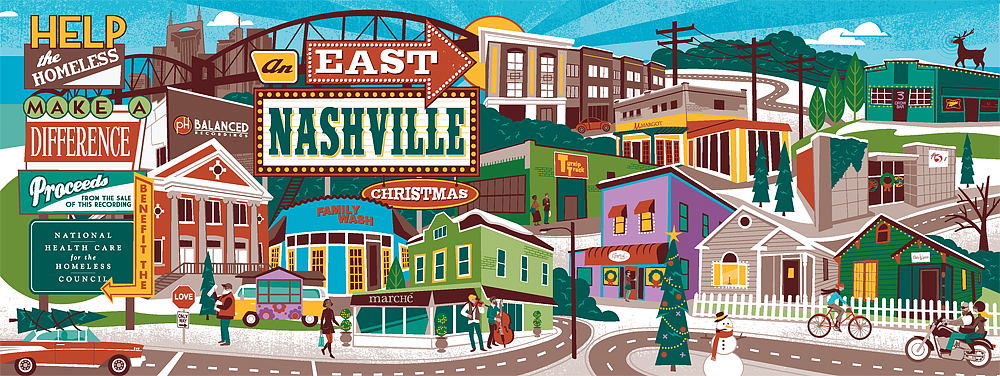On a chilly evening in early December, the East Nashville skyline was aglow in a bright, periwinkle haze. Not the haze that neighborhood troubadour Todd Snider sang about on one of his many tributes to his side of the Cumberland River, the kind that emanates from a tightly rolled joint smoked next to the local liquor store. On this night, the light came via a massive, multi-story rig from the set of ABC’s Nashville, filming an upcoming episode here, in the “hip” part of town. It was the sort of blue glow that’s usually reserved for the deep-sea section of aquariums, where kids press their noses against the glass to get a better look at the sharks, leaving snot trails in their wake.
It’s appropriate, anyway — lately, East Nashville, and its music scene in particular, has felt more and more like a fishbowl. For the past few years, as Americana has morphed into the new rock & roll and outlets from The New York Times to The Guardian have examined everything from the lure of its coffee shops to its music-making garages, the attention has turned a town into a trend, a place into a verb. Once known as somewhere starving artists flocked for cheap housing and cheaper beer, but feared by tightly-wound suburbanites, it’s now a stop for tour buses looking for guys like Avery Barkley, the “dead sexy East Nashville hipster” on Nashville.
It’s hard to blame them. There is an undeniable mystique about the place and the people associated with East Nashville (associated, not always inhabiting, being the operative word). In the country/Americana realm, voices like Margo Price, Nikki Lane, Cale Tyson, Andrew Combs, Rayland Baxter, Kelsey Waldon, Caitlin Rose, Joe Fletcher, Michaela Anne and Steelism are some of the dominating names — all coming to represent a sound more enamored by craft than chart-topping, more comfortable with Telecaster slides than synthesizers.
Of course, there are also scores of other artists who work and play in East Nashville just as hard, whether making their own music or playing in the bands of Sturgill Simpson and Jason Isbell. They might not have the spotlight of, say, Dave Rawlings and Gillian Welch, who moved here in the early Nineties, but these singer-songwriter-musicians are just as vital.
Comparisons have been made between East Nashville’s music scene and a Sixties Greenwich Village — and it’s true, there’s a rare spirit of collaboration here. Everyone plays on each other’s records, goes to one another’s shows. When Price, newly signed as Third Man Record’s first country artist, held a single release party at local venue the Basement East, she sold it out — to over 400 friends and strangers. Rose joined her onstage for a song; Tyson and Michaela Anne floated in the crowd. Elsewhere, Combs’ band on All These Dreams included members of Steelism, who have also contributed to Baxter’s songs, an artist who made his first public entrée on Rose’s “Shanghai Cigarettes.” Subtle folksinger Erin Rae McKaskle can often be spied onstage with Price or Combs, when not supporting her own LP Soon Enough — and she’ll happily share local pedal-steel player Brett Resnick with Waldon and Tyson. Nobody is worried anyone will steal trade secrets: they’d rather divulge those secrets to see what they inspire next.
A few years ago, the thought of seeing someone from the traditional Nashville institution on this side of town would have been somewhat ludicrous. The music that people like Price or Combs made was as dangerous as they perceived the now-gentrifying streets to be. But when Kip Moore, Sam Hunt, Ashley Monroe and Charlie Worsham (an East Nashville resident) staged special shows or Number One celebrations this year, they did it on the East Side — it’s a way to signal that they, too, didn’t care to follow the mainstream genre rules to a T.
For a while, the Cumberland may as well have been the Pacific Ocean (continue reading)
